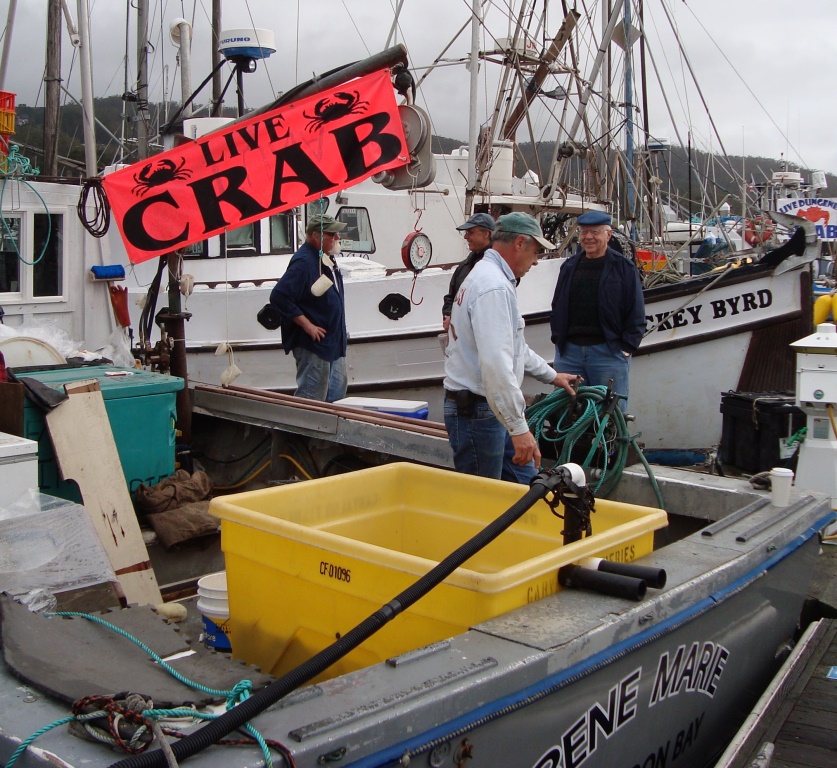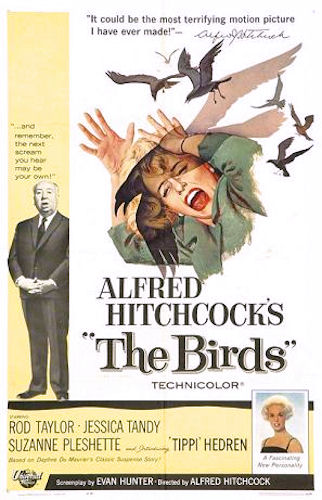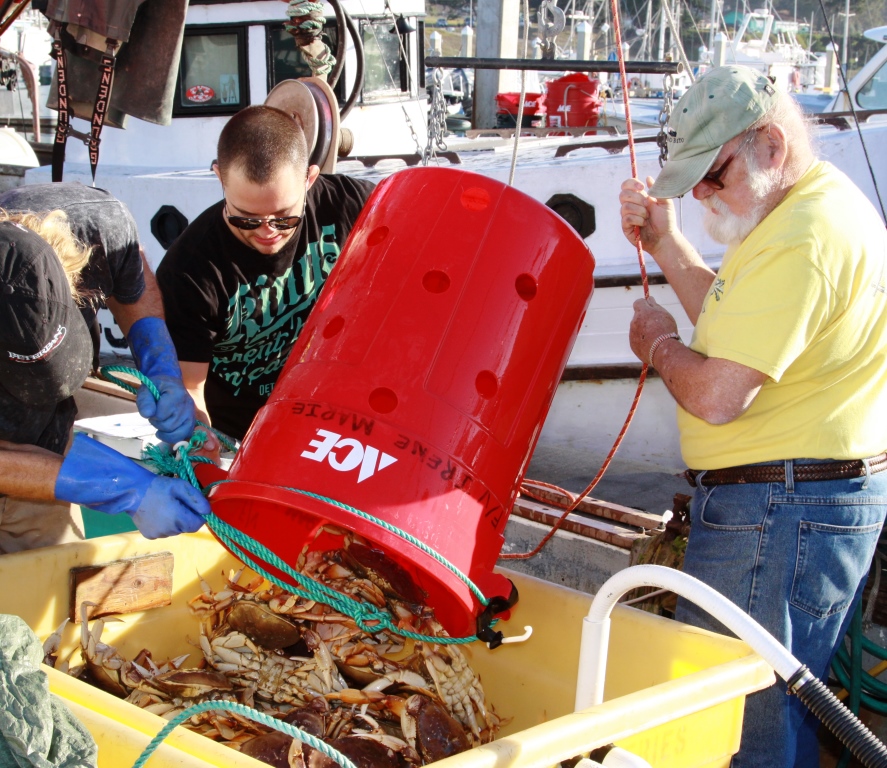Toxin in Dungeness Crab Causes Brain Damage
 Commercial Crab Fishermen, Pillar Point, CA
Commercial Crab Fishermen, Pillar Point, CA
The California Fish and Game Commission has banned crab fishing until further notice after detecting high levels of a neurotoxin in Dungeness and rock crabs. The toxin, domoic acid, is produced by certain types of planktonic algae, and it becomes concentrated in tissue of crabs and other marine organisms during plankton blooms. People who consume sufficient quantities of the toxin develop amnesic shellfish poisoning, so named because it kills neurons in a part of the brain that is critical for memory. Here’s how it works.
To most of us it comes as a surprise that crabs can be toxic, but we are all familiar with the rule that oysters should not be eaten except in months that contain the letter “R.” The mnemonic is a clever way to remember not to eat wild oysters and other shellfish during summer months, because the warm water fuels blooms of phytoplankton that contain toxins. Since the toxins are not broken down readily or rapidly eliminated from the body, they become concentrated in tissue as the shellfish filter feed on microorganisms suspended in the water.
Paralytic shellfish poisoning results from eating mussels, clams, oysters, or scallops that contain high levels of saxitoxin, a natural substance produced by certain types of plankton (dinoflagellates and diatoms). Paralysis is caused by the toxin blocking the mechanism by which neural impulses are generated in our nerve fibers (axons). The extremely potent toxin prevents sodium channels in neuronal membranes from functioning. To generate an electrical impulse, voltage-sensitive sodium channels open briefly to allow positively charged sodium ions to rush into the neuron, raising the voltage transiently and producing a voltage spike called an action potential. These voltage spikes are the fundamental mechanism by which our nervous system communicates.
A different type of marine toxin, domoic acid, from a different family of diatoms (Pseudo-nitzschia) is responsible for amnesic shellfish toxin, and this is what closed crab fishing in California. This toxin poisons the brain in a different way. A celebrated outbreak of mass domoic acid poisoning of seabirds in August, 1961 in Capitola, California was the inspiration for Alfred Hitchcock’s horror movie, The Birds (1963). Baitfish (sardines and anchovies, for example) accumulate domoic acid during algal blooms and the fish become toxic to seabirds and marine mammals feeding on them.  The neurotoxin causes bizarre behavior, seizures, and mass deaths of marine mammals and birds. As sensationalized in the movie, seabirds in the Capitola outbreak of domoic acid poisoning were observed screaming, flying erratically, and smashing through glass windows and crashing into other objects.
The neurotoxin causes bizarre behavior, seizures, and mass deaths of marine mammals and birds. As sensationalized in the movie, seabirds in the Capitola outbreak of domoic acid poisoning were observed screaming, flying erratically, and smashing through glass windows and crashing into other objects.
In people, consumption of domoic acid causes nausea, diarrhea, and abdominal cramps shortly after eating tainted shellfish. Within 48 hours this can develop into headache, dizziness, confusion, motor weakness, and in severe cases, short-term memory loss, coma, and death. In 1987 three people died in Prince Edward Island, Canada, from eating mussels contaminated with domoic acid. Clearly, domoic acid does not block action potentials–the frenzied activity of birds and marine mammals suffering domoic acid poisoning is the opposite of paralysis.
In fact, domoic acid works much like nerve gas used in chemical warfare–it causes intense firing of synapses. The uncontrolled firing of synapses sends the nervous system into a frenzy of uncontrolled activity, seizure, and kills neurons by over stimulation. Nerve gas works by overstimulating synapses that use the neurotransmitter acetylcholine for signaling at synapses, so the effects are quite different. Acetylcholine is the transmitter used to contract our muscles, for example. Sarin nerve gas results in rapid, gruesome death through respiratory failure caused by paralysis of the diaphragm (in addition other horrible and painful effects on the body that depend on synapses signaling by using the neurotransmitter acetylcholine).
Domoic acid acts by mimicking the neurotransmitter glutamate, which is the most common type of neurotransmitter in the brain used by synapses that excite neurons. (Other neurtransmitters, for example GABA, work by inhibiting neurons from firing.) A closely related compound, kainic acid, also originally derived from algae, works in a similar manner to domoic acid. Kainic acid is frequently used in laboratory studies of epilepsy (including in my laboratory), because it overexcites neurons that receive input from excitatory synapses that use glutamate as the neurotransmitter. A part of the brain critical for short-term memory, and also frequently the focus for initiating seizures, is the hippocampus. Kainic acid or domoic acid cause seizures and kill hippocampal neurons through over stimulation. Thus, the crazed birds in Capitola, and the loss of short-term memory in people who consume shellfish with high levels of domoic acid, are caused by over-excitation and death of neurons in the brain that respond to the neurotransmitter glutamate. Nasty stuff indeed!
But why crabs? The answer has to do with how the toxin is ingested and eliminated by different types of organisms. Muscles and oysters, for example, eliminate domoic acid from their body within hours or a few days, but razor clams are poor at eliminating the toxin. Several months to years after ingesting domoic acid, only half the initial dose is gone from razor clam tissue. This June levels of domoic acid in razor clams in Washington State reached record levels. Studies on Dungeness crabs show that within two hours of ingesting domoic acid, the toxin is deposited in the hepatopancreas, while other tasty tissues retain extraordinarily low levels of toxin, 100 to 1000 times lower than in the hepatopancreas. Crabs are not very efficient in excreting the toxin, so crabs feeding on contaminated shellfish absorb domoic acid very efficiently and eliminate it slowly in urine.
If you are not familiar with crab anatomy and would like to be able to identify the hepatopancreas where domoic acid accumulates, look up the episode of Parts Unknown by TV personality and former chef, Anthony Bordain in the recent program about restaurants in San Francisco, and you will see him slurping up what is yellowish crab innards, sometimes called the mustard, with a slice of sour dough bread and raving about the flavor while poking fun at folks who are too persnickety to enjoy the rich taste of crab guts. (Possibly he now has no memory of doing this.)
Domoic acid is tough stuff, and dangerous. It can’t be broken down by cooking or freezing or by digestion and it latches on to glutamate receptors with a vengeance. But let’s not get hysterical and freak out like people in the fictional movie The Birds. Fatal poisoning caused by consuming shellfish contaminated with domoic acid is rare. The example of the three unfortunate people who died on Prince Edward Island in 1987, illustrates how far back we must go to find cases. I venture to say that countless more unfortunate people have choked to death on a steak dinner during the same interval.
Crabs and shellfish contaminated with domoic acid are to be avoided. They will make you sick and in high levels cause serious harm to your brain, but the key is dosage. Marine mammals and birds eat essentially nothing but fish and so they receive high dosages of the toxin when it is present in their prey. Unlike invertebrates, vertebrates are quite good at eliminating domoic acid. (But domoic acid also causes kidney damage.) In low doses, the effects of domoic acid are not much different from half an asprine, which is to say nonexistent. Domoic acid and kainic acid are even used as drugs in low concentrations to treat people suffering from intestinal worms, because the vermin succumb to doses far below those that have any negative effects on the human body.

Capt. John Hurwitz and crew unloading their catch of Dungeness crab, Pillar Point Harbor, California
The point is, all things shall pass. Sometimes fishing is good, sometimes it is not. Nature works in fits and cycles. Some years, such as right now, the complex mixture of favorable weather, currents, and nutrients, all come together to cause a population explosion of particular types of algae, but thanks to the biologists who work for the California Department of Fish and Game and other agencies who constantly monitor levels of toxins, heavy metals, and other poisons in our seafood, we can eliminate the risk. These scientists will let us all know when it’s time to dine on something else–a far better way to go than trusting in the old “month with and R in it” rule. Let’s also remember that many hard working California crab fishermen are going to have a very difficult time for a while, but when the coast is clear and the algal populations drop to where domoic acid levels are normal in seafood again, that famous California Dungeness crab of is going to taste all the sweeter!
(Disclaimer: I once worked as a biologist for the California Department of Fish and Game. I absolutely love Dungeness crab. I don’t eat the guts. I watch Anthony Bourdain’s show almost every Sunday night. The skipper of the crab boat in the photo is a friend, John Hurwitz. He’s a long-time crab fisherman and writer. I once traded him an article I wrote about sharks published in Scientific American in exchange for live crabs fresh off his boat–a windfall compared to the usual rate of a dollar/word.)
References
Domoic acid: A major concern to Washington state’s shellfish http://wdfw.wa.gov/fishing/shellfish/razorclams/domoic_acid.html
Fields, R.D. (2007) The Shark’s Electric Sense. Scientific American, August, 2007 http://www.scientificamerican.com/article/the-sharks-electric-sense/
Pelley Scott (2015) A crime against humanity. Scott Pelley reports on the 2013 sarin gas attack in Syria that U.S. intelligence estimates killed more than 1,400 civilians. CBS News 60 Minutes, August 23, 2015, http://www.cbsnews.com/news/syria-sarin-gas-attack-in-2013-60-minutes-2/
Schultz, I.R., Skillman, A., Sloan-Evans, S., and Woodruff, D. (2013) Domoic acid toxicokinetics in Dungeness crabs: New insights into mechanisms that regulate bioaccumulation. Aquatic Toxicology, 140-141, 15 September, 77-88.
Sabalow, R., and Kasler, D. California delays opening of crab season amid toxic scare. The Sacramento Bee, November 5, 2015. http://www.sacbee.com/news/state/california/water-and-drought/article43186440.html
Tuder, Stefanie, Everywhere Anthony Bourdain Eats in San Francisco ‘Parts Unknown’, October 18, 2015, 7:00 pm, CNN.
http://sf.eater.com/maps/anthony-bourdain-parts-unknown-san-francisco-restaurants
Photo credits: Crab boats, Douglas Fields. “The Birds original poster” by Copyrighted by Universal Pictures Co., Inc.. – http://www.impawards.com/1963/birds.html IMP. Licensed under Public Domain via Commons -https://commons.wikimedia.org/wiki/File:The_Birds_original_poster.jpg#/media/File:The_Birds_original_poster.jpg